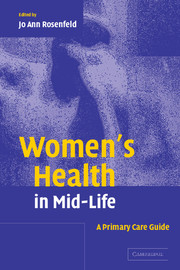Book contents
- Frontmatter
- Contents
- List of contributors
- 1 Introduction
- Part I Health promotion
- Part II Hormonal changes
- Part III Disease prevention
- Part IV Cancer prevention
- 16 Breast cancer: screening and prevention
- 17 Cervical cancer: prevention, screening, and early detection
- 18 Endometrial cancer: prevention, screening, and early detection
- 19 Ovarian cancer: prevention, screening, and early detection
- 20 Colon, lung, and skin cancer: screening and prevention
- 21 Common gastrointestinal and urinary problems
- Index
- References
20 - Colon, lung, and skin cancer: screening and prevention
from Part IV - Cancer prevention
Published online by Cambridge University Press: 21 August 2009
- Frontmatter
- Contents
- List of contributors
- 1 Introduction
- Part I Health promotion
- Part II Hormonal changes
- Part III Disease prevention
- Part IV Cancer prevention
- 16 Breast cancer: screening and prevention
- 17 Cervical cancer: prevention, screening, and early detection
- 18 Endometrial cancer: prevention, screening, and early detection
- 19 Ovarian cancer: prevention, screening, and early detection
- 20 Colon, lung, and skin cancer: screening and prevention
- 21 Common gastrointestinal and urinary problems
- Index
- References
Summary
Colorectal cancer: prevention and screening
Epidemiology
Colorectal cancer is the second most common cancer and the third most common cause of cancer death in women (Figure 20.1). Although breast and gynecological cancers may be mentioned more commonly, colon cancer causes 55 000 deaths yearly in the USA1 (28 000 in women) and 15 000 deaths yearly in the UK. It may be prevented. A person at age 50 has about a 5% lifetime risk of being diagnosed with colorectal cancer and a 2.5% chance of dying from it; the average patient dying of colorectal cancer loses 13 years of life (Table 20.1). Ninety per cent of colon cancers occur after age 50 years. More men than women over age 50 develop colon cancer, but because more women live longer, the total number of cases is higher in women.
Because most colorectal cancers arise from adenomatous polyps, removal of these polyps during colonoscopy and sigmoidoscopy can prevent colon cancer. Ten per cent of adenomatous polyps larger than 1 cm will develop into cancer within ten years. Colonoscopic removal of polyps results in a 76–90% reduction in colon cancer over six years. Primary prevention by reduction of risk factors may decrease the risk. In addition, screening is effective in reducing or preventing morbidity and mortality.
Screening
The US Preventive Services Task Force (USPSTF) has made an A recommendation that all individuals over age 50 years should be screened for colon cancer.
Keywords
- Type
- Chapter
- Information
- Women's Health in Mid-LifeA Primary Care Guide, pp. 327 - 334Publisher: Cambridge University PressPrint publication year: 2004



